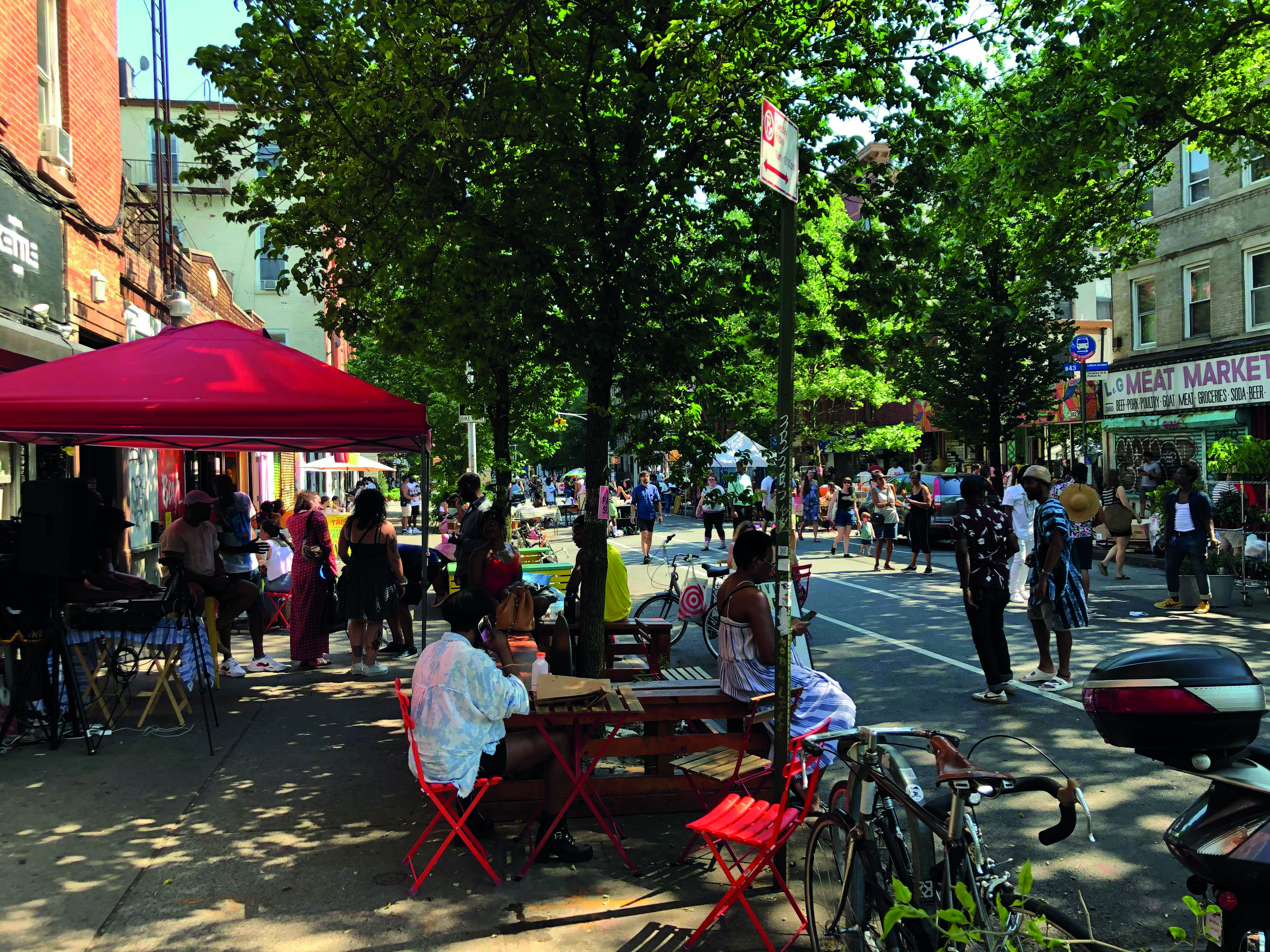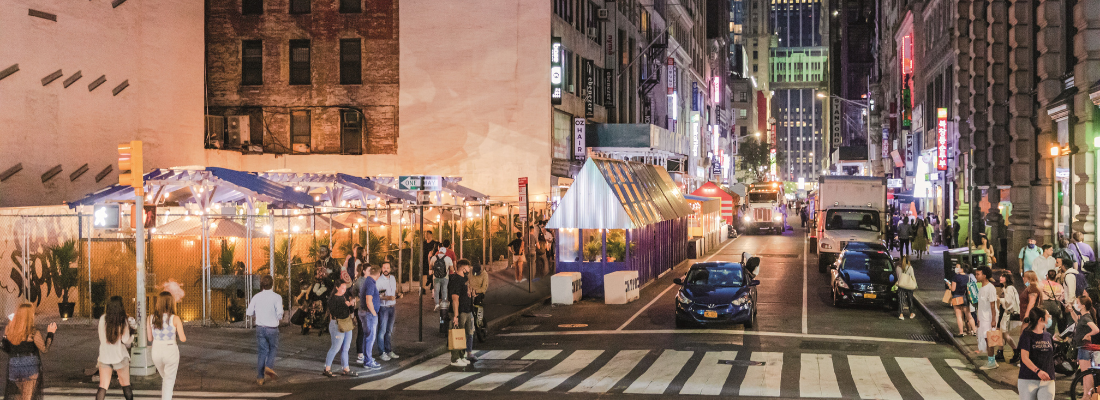COVID-19 and traffic management
Space to breathe
Covid-19 has changed the way cities around the world are managing public space and traffic flow, with parking lots turning into al fresco dining areas and new cycle lanes popping on urban streets. But are these changes here to stay and how have they impacted congestion?
The Covid-19 crisis has led to major changes in the way public space is used in Europe’s urban centres. As lockdowns began to lift in the summer of 2020, European cities, like their counterparts around the globe, found themselves with quiet streets and urban populations desperate for some respite after weeks, sometimes months, of stay-at-home orders in place.
In response to this came a boom in outdoor dining and along with it a proliferation in dedicated cycle paths. In Milan, Italy, for example, the lifting of a tax related to restaurants and bars’ square footage paved the way for around 1,500 businesses to expand their outdoor facilities, resulting in the loss of around 3,000 parking spaces, notes Arianna Censi, Milan’s city councillor for mobility.
Known as parklets, these al fresco dining spots became common in many other European cities. At the same time large sections of many city centres became cut off to cars.
In Paris, the city’s iconic Rue de Rivoli, which runs adjacent to the Louvre, was turned into a multi-lane bicycle highway as the city’s mayor, Anne Hildago, designated more than 50km of traffic lanes to bikes. In London, meanwhile, the emergence of so-called pop-up bike lanes saw protected cycleways created on Park Lane in the West End and another on Euston Road in central London.
Permanent fixtures?
This repurposing of outdoor space was mirrored throughout the world. In New York City, for example, a total of 8,550 parking spots were given up for outdoor dining at the height of the pandemic. In most places these changes have been welcomed. In Milan, for example, Censi says that while “there have been some protests” it is much less than in the past when similar changes to public space were attempted.
In Brooklyn, New York, whole streets were made inaccessible to cars during lockdowns…
And in Queens an exercise class took place in the middle of a road
She puts this down to a change in our priorities brought on by the pandemic. “The need for outdoor spaces and the desire to socialize after long closures were widely shared by people and have been satisfied by the rise in outdoor dining,” says Censi.
The popularity of these Covid-era measures means that many cities are considering making them permanent. In London, local councils in the west and central areas of the city have already signalled their desire to make outdoor dining a permanent fixture. There are also plans to establish pedestrian piazzas on either side of the city’s busiest pedestrian junction, Oxford Circus."We are all waiting for a return to normalcy in everyday life but, in terms of mobility, I would not want to step back from the results achieved this last year and I would like to maintain many of the choices we have made as permanent - Censi
In Paris too, Mayor Hildago has publicly stated her intention to retain the car-free measures brought in during the pandemic. This feeling is echoed in Milan by Censi. “We are all waiting for a return to normalcy in everyday life but, in terms of mobility, I would not want to step back from the results achieved this last year and I would like to maintain many of the choices we have made as permanent,” she says.
But if these Covid-era changes are to become permanent, what will be the impact on traffic flow and congestion? Isn’t there a danger that restricting car access in one area will lead to congestion elsewhere in the city, especially as traffic volumes return to normal?
According to Censi, the evidence so far suggests not. “Road use is currently a little higher than it was pre-pandemic,” she says. Yet despite this they have seen only a “low impact on traffic flows” from the Covid-era changes to public space.
Careful planning
Censi puts this down in part to the city’s careful management of the changes, which were not restricted to the parklets and included the roll-out of 35km of new cycle lanes and a programme to pedestrianise several of Milan’s piazzas.
“All our interventions were deeply evaluated using computer modelling to estimate their impacts on places and people,” says Censi. “At the same time, they were also the result of a long engagement process with residents.”
In some cases, the pedestrianisation of public space was mitigated against alterations to traffic routing. “In several cases it was necessary to create one-way roads, especially when there were several streets leading to the same square,” she adds.
It was also managed through traffic calming measures. In the QT8 district in the west of Milan, for example, some roadways were narrowed, and the sidewalks widened “with the purpose of naturally decreasing cars’ speed and creating more space for pedestrians,” Censi explains. A number of 30km/h zones were also introduced in several areas of the city.
According to Nikos Tsafos, an expert in sustainable cities and mobility at the Center for Strategic and International Studies (CSIS), a Washington DC-based think-tank, lowering speed limits on the periphery of the newly-pedestrianised areas helps make them safer to access. He believes this is also part of a general trend in the traffic management of cities that is seeing the priority shift away from traffic flow.
“Maximizing flow can only come when you prioritise cars over other forms of transport,” says Tsafos. “I think there are many city mayors who would say that their goal is not to have cars move as quickly as possible through the city because that leads to fatalities. Their goal instead is to create friction, to slow traffic down.”

Empire Diner in Manhattan has used road space to create an alfresco dining area
Impact on congestion
Tsafos thinks this trend away from prioritizing road traffic was likely only furthered by the pandemic where many cities were able to experience first-hand the positive impact reducing car access can have on a city’s vitality. “A lot of business owners think that their money comes from cars being able to access them,” says Tsafos. “Whereas what we see a lot of times is that when you shut down the streets you increase pedestrian flow, and businesses benefit. They were able to see this for themselves during the pandemic.” Tsafos also believes that the lack of impact the changes to public space in Milan have had on traffic congestion may be less to do with good planning and more because of how driver behaviour changes in accordance with accessibility.
He says: “While we haven’t had time to study what has happened with the pandemic, cities have a lot of experience of converting streets to pedestrian-only and the thing that we’ve learned in general is that traffic adjusts. If you make more space for cars, more people use cars. But if you take space away, car use shrinks.”
Tsafos gives the example of the creation of a large pedestrian plaza in New York’s Times Square in 2014, which despite the concerns of the then-mayor Michael Bloomberg, had little adverse effect on congestion in the city.
The changes to public space in New York brought on by the pandemic are also not believed to have had much impact on traffic congestion even as traffic volumes have returned to their pre-pandemic levels, notes a spokesman for the New York City Department of Transportation.
The importance of transit
"It’s very difficult to restrict car traffic in the absence of compelling alternatives- Nikos Tsafos, expert in sustainable cities and mobility at the Center for Strategic and International Studies (CSIS)
But in the case of Milan and New York, these are both cities with good public transport systems. In places where this is not the case the Covid-era changes may be harder to retain, Tsafos believes. “It’s very difficult to restrict car traffic in the absence of compelling alternatives,” he says.

In Milan, pandemic lockdowns were the catalyst that led to the remodelling of roadways into urban, outdoor social spaces – leading in turn to new traffic-management challenges
He thinks the same holds true for reducing parking space availability. “If you take away parking spots but there are no transportation alternatives all you’ve done is reduce mobility services and accessibility to the city,” he adds.
In the absence of mass-transit alternatives promoting cycling is one way to mitigate against the transportation loss you create when you reduce car use. Many European cities took advantage of the unusual circumstances offered by the pandemic to prioritise bike use.
In both Italy and France programmes were established whereby residents who invested in bikes were eligible for government stipends. In Paris, the expansion of the cycle lanes was incorporated into a broader vision of the 15-minute city, a new concept in urban design that starts from the proviso that all residents in a city should have access to essential urban services within a 15-minute walk or cycle.
In Milan too, Censi notes that the changes that have happened in response to the pandemic are part of a bigger shift that is seeing the city move its mobility priorities from four- to two-wheeled transport.
She says that bike use in Milan has yet to take off to the same levels as in other European cities such as Copenhagen, Amsterdam, or Paris. She thinks this is “partly for cultural reasons, and partly for safety reasons.”
Even so, says Censi, “the goal is to increase cycle lanes to consolidate and increase the use of bikes.” She adds: “The traffic has now returned to pre-pandemic levels but the goal over time is to decrease the number of cars circulating in Milan. I don’t think we’ll go back to how things were.”
This article is part of the Intertraffic World Magazine.
View the digital version of the magazine here.
Share your story
Do you have an innovation, research results or an other interesting topic you would like to share with the professionals in the infrastructure, traffic management, safety, smart mobility and parking industry? The Intertraffic website and social media channels are a great platform to showcase your stories!
Please contact our Sr Brand Marketing Manager Carola Jansen-Young.
Are you an Intertraffic exhibitor?
Make sure you add your latest press releases to your Company Profile in the Exhibitor Portal for free exposure.
Get up to speed on the mobility industry - our newsletter straight to your inbox!



